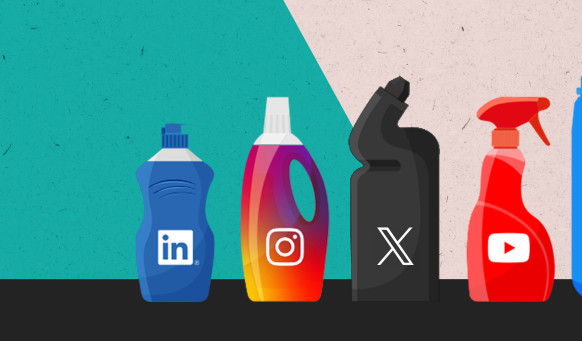As a marketing and PR agency, we’re often asked about the benefits and impacts that social media can make to a business; and as such, we also regularly have to address the misconception that social media should be done in isolation. Social media should support all your company’s marketing activity and should form part of your overall marketing and PR strategy - very rarely can a business rely entirely on social.
Social media is a communications platform that allows you to drive awareness, engagement and traffic to both your brand and your other communications. It can support your printed material, your PR, video, audio, event and networking activities successfully. Much like in-person events, social networks are another way to reach people that matter to you and your business; so, let’s take a look at how it all works.
Identify your content
You know who your target audiences are and who your competition is, so find them online. Look at the social channels they are engaging with, identify the content they like and identify the information they are seeking about the products and services that your company offers.
Creating content
Create useful, meaningful, organic (i.e. not sponsored) content that works for each platform, go in-depth about your product, service, team, the ways you work and beyond.
This is your chance to show your brand’s personality, reveal your human side, and most importantly, build a community on trust.
- Showcase the achievements of your team and share company news that helps reinforce your successes. For example, details of award wins, charity work, training days and anything that shows the best of your team in action.
- Highlight behind-the-scenes activity: a team member out on a job, special days in the office, team events, whatever best reflects your positive company culture.
- Beyond this, it’s good to remember that by providing staff with even basic social media training, they too can become company ambassadors, sharing your content to their own networks and broadening your reach even further.
So you’ve started to reveal your human side
Now it’s time to talk about what you can do for your future business partners. Around your other content, start highlighting your benefits over the competition, but keep it friendly and remember social networks are built on human interaction. You can showcase products and their features and also promote your services and why people need them.
We know that B2B marketing has a long cycle, so encouraging engaged staff is important, as they will gladly talk about your products or services in a way that doesn’t seem forced, helping build trust, answering questions and generally raising the profile of your business. It’s like B2C, but targeted at business customers. Businesses make purchasing decisions, much like individuals, so they’re also looking at reputation, support and educational content that they find useful and share (which can even lead to referrals later).
Regular posting
So how often should you post your content? We suggest posting three times a week as posting regularly to LinkedIn, Twitter, Facebook, Instagram and YouTube (among others) with high-value content means that you’re distributing your message directly to potential clients, customers and decision-makers. You might start with your content that’s been published elsewhere, like an article, a document (e.g. a whitepaper), video or animation - this is known as repurposing and is the backbone of your digital strategy. On top of this, you might share relevant industry news, jump on trends and work on setting yourself up as a voice of authority in your area.
Next, it’s time to look at your website
As part of your strategy, your website will ideally be optimised to receive visitors from social media. Sections of your website will act as ‘landing pages’, so when somebody clicks on your post with the engaging CTA (call to action) or CTV (call to value), they’ll ‘land’ on a page that’s optimised for them to continue their journey to do business with you. Landing pages are a great way to measure conversion, as you can collect data by providing a form, publish a direct phone number to your sales team, suggest further reading or initiate a PDF download. However you measure success, your landing page should be paving the way on this journey.
Let’s think about other pages that are useful to your visitors.
- Blogs - featuring genuine, long-form writing and images about a relevant topic to your company or industry.
- News section - giving brief but helpful updates on your company’s growth and development, success stories and beyond.
- Case studies - highlighting recent projects or collaborations.
- Product/service catalogues - with in-depth detail about your offering.
- Training/CPD pages - promoting the growth and development of your team.
When done well, by using the right keywords and links on your web pages (with the help of an SEO expert), you can boost your SEO ranking and page authority on Google and other search engines. Even better, once these pages are in place, the content from them can be broken down and used as the basis for engaging social content - giving you plenty to talk about online, while further building up your SEO page ranking by creating more inbound links.
That’s a lot to consider so far, but how about some other benefits?
- By being active on social media, you’re supporting your other activities by having a brand presence online. The more you appear, the more familiar your branding will become, helping to build trust. You’re also in a position to offer better customer support, as you can manage and react quickly to issues, complaints or praise.
- To establish an even deeper understanding of your customer, you can conduct social listening and research to really find out what people are saying about your brand on social media. On a more advanced level, this valuable information can be of use when creating personalised content, which is a growing area within social media marketing.
- As social media users of today become business decision makers, they may naturally turn to social platforms to research and source products and services, so being where your customer is can be vital.
- Paid social, for example: ad campaigns, sponsored content and boosted posts can all help you to find larger and more targeted audiences that go beyond your organic reach. With well-managed budgets you can grow your audience and achieve a number of other goals online.
- Once relationships are established with your followers, you can start thinking about sales. There are many ways of converting followers and connections into customers with the right approach and timing.
How do you measure results?
As mentioned above, start out by being mindful of what success looks like to you when measuring results. A good way to keep informed is to use reporting and analytics tools - these can help to keep records of activity and generate reports. By regularly measuring and comparing data, you’ll build a picture of your platform achievements.
Here are some valuable on-platform insights that should help get you started.
- Followers and connection counts
- Impressions and engagement rate per impression
- Share of voice
- Clicks on your posts
- Likes, reactions, shares, comments - all engagement
- Mentions
And a few off-platform results.
- Website traffic from socials
- Lead conversion rates
- Downloads
- Telephone calls
- Form submissions
Summary
Of course, you could have only ten followers but they’re all hugely engaged and might be your biggest customers. Conversely, you could have 1,000 followers but may not be engaging with them effectively, so beware of chasing only big numbers. The key to good social media measurement is consistency, so you can effectively monitor at regular intervals and see what’s been working for you.
I hope this has given you some pointers. Social media can be time-consuming but with the right plan and support, it can be a powerful tool in your marketing mix. If you’d like to discuss how Fabrick could work with you on your construction and built environment social media marketing, contact us to arrange a consultation.




